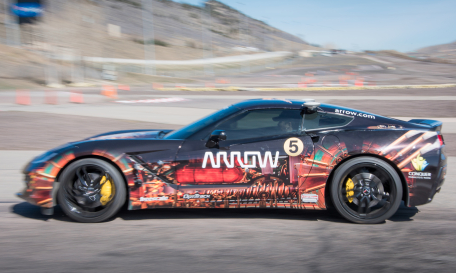Paralyzed, Former Indy Driver to Tackle Race Course with Advanced Technology
Former IndyCar driver and current Verizon IndyCar Series Team owner Sam Schmidt will drive a modified sports car on the Sonoma Grand Prix road course on Sunday in a high-speed demonstration of integrated semi-autonomous technology developed by Arrow Electronics and its partners.
Schmidt has been paralyzed and unable to use his arms and legs since a racing accident in 2000.
Driving a 2014 Corvette Stingray equipped with advanced electronics for Arrow’s Semi-Autonomous Motorcar (SAM) project, Schmidt is able to steer, accelerate and brake using only his head. Schmidt intends to conquer the twists, turns and hills of Sonoma’s 2.52-mile road course—including a 180-degree hairpin turn—in a demonstration lap prior to the start of the Grand Prix, which determines the 2015 Indy Racing League championship.
Arrow launched the SAM project in May 2014 at the Indianapolis 500, where Schmidt drove four qualifying laps in the Corvette reaching a top speed of 97 mph and garnering worldwide attention. In subsequent demonstration laps at the iconic oval speedway, Schmidt reached a top speed of 107 mph.
“I thought I would never be able to drive again after my accident, but this vehicle makes it possible for me to improve every time I am on the track,” Schmidt said. “Driving fast on a road course just a year after Indy is incredible progress.”
At Sonoma, telemetry data from the SAM car’s operation and Schmidt’s driving performance and physical status will be collected and pushed into the cloud. To drive on the Sonoma road course track, the SAM car was updated with new cameras and more responsive driving controls. The modifications allow Schmidt to make sharp left and right turns, navigate hills and synchronize acceleration and braking more precisely.
The SAM project’s objectives are not to transfer control of a vehicle to technology, but rather to enable disabled drivers to enjoy the driving experience by leveraging the power of technology.
The SAM car integrates the following technology:
- Infrared camera system: sensors mounted on Schmidt’s hat connect to infrared cameras mounted on the dashboard that detect his head-tilt motions in order to steer.
- Sip/puff system: using breath control, Schmidt can accelerate and brake the vehicle by sucking or blowing into a tube attached to a Freescale-integrated pressure sensor.
- Computer system: a central processor from Freescale collects signals from the camera and sip/puff system to control the car’s acceleration, braking and steering.
- GPS technology: a guidance system keeps the car within 1.5 meters from the edge of the track, providing Schmidt with a virtual envelope about 10 meters wide within which he steers.
- Safety system: a set of software algorithms ensure the commands sent to the computer system are real and defined within the vehicle’s limits.
Category: Featured, General Update











